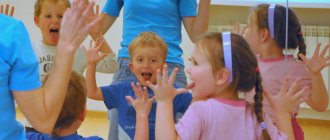Finger gymnastics: how to determine the level of development of fine motor skills in a child, exercises for fingers in pictures and poems, exercises by Maria Montessori, shadow finger theater.
Finger gymnastics for preschool children.
Finger gymnastics is very useful for children of any age. Primary school teachers constantly note that for many children the biggest problem in learning is not the inability to read or ignorance of the basics of arithmetic, but the unprepared hand for writing. What are the reasons for graphical unpreparedness for learning to write? There are two reasons:
- Insufficient development of small muscles of the hand and nervous regulation of fine motor skills (“physiological unpreparedness” for learning to write).
- Lack of development of the skill of performing graphic movements (“psychological unpreparedness” for learning to write).
Both of these difficulties can be prevented if you engage in finger gymnastics and special exercises with children from the age of 3, and also involve your child as actively as possible in making crafts (drawing, appliqué, artistic work, modeling), in household work (embroidery with a thick needle, knitting and weaving for girls, making crafts from wood and natural materials, bars, packaging for boys).
How to determine the level of development of fine motor skills in children: diagnostics. Three simple tests.
This does not require any complex manuals or items. And it will take very little time. I want to talk about three simple tests for diagnosing the level of development of fine motor skills, which can be carried out with children of senior preschool age at home, in kindergarten, and in a children's center (the authors of the tests are N.V. Nizhegorodtseva, V.D. Shadrikov. Psychological and pedagogical readiness of a child for school - Vlados, 2001).
Test 1.
The child is sitting at the table. Take a large sheet of paper and ask the child to place his hands so that both palms with fingers apart fit on the sheet of paper. Trace your palms on paper with a pencil. Look together what you got. And ask the child to place his palms on the paper again so that all the lines match.
Explain the task. Invite your baby to play with his fingers. Say: “I will show you the fingers on your hand, and you will only lift the finger that I show. There is no need to raise other fingers.” Try it - ask your baby to raise his finger: “Pick up this one.” Make sure he understands the task correctly.
Now let's start the test. Start with your right hand: “Lift up this finger. And now this one.” Sequence of movements: 5-1-2-4-3 (where 1 is the thumb and 5 is the little finger). Then, in the same sequence, do the task on your left hand. Then repeat on the right. And again on the left. This way, each hand will complete the task twice!
And now the main thing is what you need to keep an eye on when performing this task. When the baby tries to lift one finger, the others will involuntarily lift. He doesn't want it, but it works out that way! These extra movements are called synkinesis. Such unnecessary movements occur when the movements of the fingers are not sufficiently differentiated, and therefore muscles unnecessary for this movement are activated.
When you see synkinesis, then draw each of them with an arrow on paper, drawing a line from the desired finger to the “unnecessary, superfluous” one for this movement.
As a result, by the end of the task you will have on paper the contours of your palms and drawn lines of unnecessary movements. One extra movement is one arrow.
How to find out test results:
1) We count the average number of arrows for each hand, i.e. average amount of unnecessary movements. For example, we have 6 arrows drawn on our right palm, and we carried out the task twice. Therefore 6:2 = 3. That is The average number of extra movements of the fingers on the right hand is 3.
Similarly, we count the extra movements of the fingers on the left hand - for example, we have 8 arrows drawn. 8: 2=4. The average number of unnecessary movements is 4.
2) Add up the resulting numbers. 3 (on the right hand) + 4 (on the left hand) = 7.
What do these results tell us:
- What is the child's dominant hand? The leading hand is the hand where differentiation of finger movements is better developed, and where there are fewer unnecessary finger movements. In our example, this is the right hand.
- What is the level of development of subtle movements and their differentiation in a child. Approximate age norms (total average number of extra movements): at 6 years old - 9, at 7 years old - 6, at 8 years old - 5, at 9 years old - 3. For our example: we got the number 7. For a six-year-old child this is a good result. But if the child were already 7 years old, then the result is too low, i.e. This child's finger movements are not sufficiently developed.
Now it’s probably clear why children who learn to play the piano and other musical instruments are often much more developed than their peers? After all, they exercise constantly and actually constantly do finger exercises





